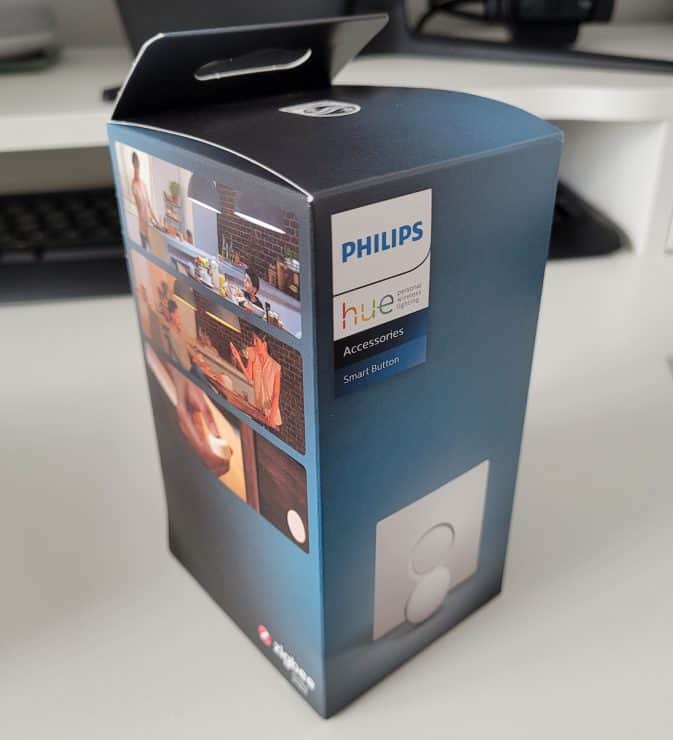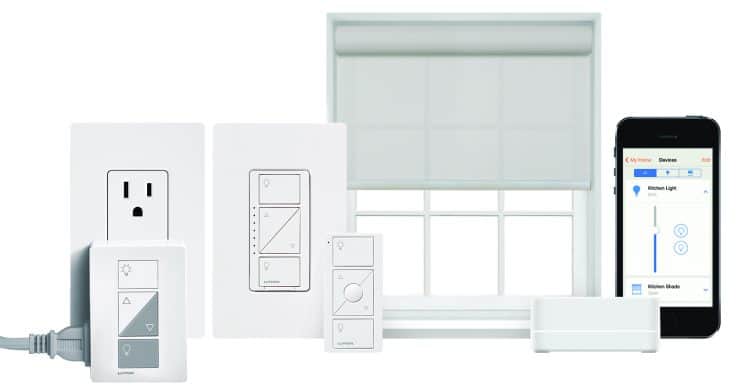People sometimes think that in order to have a fully smart lighting system, you need to buy smart lights and also smart bulbs. But this isn’t always correct. In-fact it’s sometimes better to either have smart lights, or to have smart bulbs – not both.
Having just smart switches means that you still get lots of the benefit of smart lighting (such as motion-activated lights), without the need to buy expensive smart bulbs and keep the standard switch permanently on.
The types of smart switches and sensors

There’s various types of smart switches and sensors, with the most common being:
- Simple on/off switches, with remote control (via an app) making it smart.
- Smart dimmer switch, which has the capability to reduce the brightness of a bulb as required.
- Smart tap switches, which can be programmed to perform a specific action (including turning on a group of lights) when pressed.
- Motion sensors, which detects when someone has walked into a room and automatically turns a light on (or off, when you’ve left the room). It’s convenient, and feels like something out of sci-fi!
- Smart touchscreen – you can have fancy looking light switches which actually have a touchscreen, and sometimes with a touch-based control to the side for quick tasks. The Brilliant Home Control switch is a neat example of this.
The way that these work can also vary:
- Hardwired – these replace your existing wall switches by being hardwired into your house’s electrics. They can then perform a greater range of functions (without having to worry about draining an internal battery) and you don’t have a separate, duplicate dumb light switch hanging around too. However it’s more complex to install, for someone whose not competent at electrics. They also tend to act on a single bulb, or whatever bulb(s) the previous switch controlled.
- Free-standing – a smart switch/sensor which can be placed anywhere around the house: on walls, tables or even the floor! Philips Hue’s range of switches are all free-standing. These contain a battery, and they can often be programmed to control any number of smart bulbs. They do, however, have the downside that your existing switches remain – making it easy to turn off your lights by mistake. These types also only work with smart bulbs, not existing dumb lights.
As you can tell, hardwired smart switches are more suited to replacing your existing switches one-by-one, introducing smart-control lighting into your home light-by-light. Free-standing switches, on the other hand, are more of an add-on to your existing smart bulbs – they can’t magically control your hardwired dumb lights. They are, however, very useful in controlling large groups of smart lights without the need for rewiring your house.
How smart switches & sensors can be used with dumb bulbs
As touched on above, smart switches (and sensors) can be installed in one of two ways: they can be hardwired, or free-standing.
Free standing switches can only control your existing smart bulbs, by nature of the fact that they aren’t wired in anywhere and hence can’t magically control your existing, hardwired lights.
As a result, if you want to make your dumb bulbs smart (well, smarter), you must go for hardwired switches/sensors. Your house’s existing electrics is the only way that your dumb bulbs can be communicated with, after all.
So what you’ll do, for example, is run out and buy some Leviton Decora smart WiFi switches and hardwire them into your wall:

You can then download the ‘my leviton’ app, and setup smart control here. This is better than having just smart bulbs, which will mean that you still have a wall switch – but it must be left on all the time (otherwise the smart bulb has no power, and hence it can’t smartly turn on/off). This is a frustration for smart bulb-only adaptors, who then buy shields to stop people accidentally turning the wall switch off:

So by going out and purchasing hard-wired smart switches, you get the following benefit:
- No duplicate dumb switch lying around. As explored above, if you have only bought smart bulbs, you’ll still have your old wall switches – but they must be left on all the time. Converting just the wall switch (to be smart) solves this problem.
- Ability to have more powerful smart functionality. A hardwired device can be more flexible – and offer better features – than a battery-only alternative, since it doesn’t have to worry about conserving battery power (just like a hardwired Ring Doorbell Pro offers many more features than the battery-based Ring doorbells).
- More consistency. A hardwired smart light switch is ultimately still a hardwired switch, which should work 100% of the time. This compares to smart bulbs which can be a bit unreliable and only work 95% of the time (temporary signal or range issues may block the message to turn a light on/off).
However there are some downsides:
- They only control a single light (or group of lights). They will control whatever light(s) your old switch controlled. This is usually a single light, but it might be multiple in the case of spotlights. Either way, you won’t be able to have a smart tap switch that turns all your house’s lights on/off (like you can do with the Hue tap switch, controlling all your Hue bulbs at once).
- No dimming on most smart switches. Pretty much all smart bulbs come with dimming functionality out of the box, however most smart switches are just on/off (whether via a physical switch, or motion activation). Yes you can buy smart dimmer switches to work with dimmable bulbs, but most smart switches won’t support dimming. They certainly won’t support it if your existing circuit’s wiring doesn’t support dimming. Hence if dimming capability is important to you, you either need to perform wiring upgrades or buy a simple smart bulb which will offer this easily.
Using both smart switches and smart bulbs (should you?)

Philips Hue candle bulbs.
Since there’s some downsides to using just smart switches, and also some downsides to using just smart bulbs, surely you should use both and there’s no problem whatsoever, right? Well…
Unfortunately not really. They are still fairly different products and a hardwired smart switch is still ultimately linked to the bulbs that its wires go directly to. This means that you can’t magically start controlling all your house’s smart bulbs from a single smart switch (unlike Hue’s battery ones which can do this, as they just send commands to the Hue controller).
Also, a smart switch will typically turn power off (entirely) to a smart bulb when someone leaves the room or flips the switch. This loses any ‘smart’ ability that a bulb has, making it effectively like a dumb bulb.
You can buy smart switches which are compatible with smart bulbs – such as the Lutron Aurora dimmer and the Inovelli Red smart switches – but in general you shouldn’t look to combine smart switches and smart bulbs unless you know what you’re doing, and there’s a specific use case that can only be achieved by combining both.
Why you can’t use Hue switches/sensors with dumb bulbs

If hardwired smart switches don’t work, the alternative would appear to be using battery-powered accessory switches – such as the entire Hue switch/sensor range.
However unfortunately, this won’t work either. Hue’s smart switches and sensors use ZigBee (a communication protocol like WiFi and Bluetooth) to speak to your Hue Bridge, and then the Bridge controls your smart bulbs.
Since the Hue Bridge can’t control dumb bulbs, Hue’s smart switches can’t either.
In other words, dumb bulbs don’t speak the same language (ZigBee) as any of the Hue ecosystem, and so Hue’s non-hardwired switches can’t help you here.
The only exception is to use Hue’s smart plug and plug a floor lamp into this. You can then connect the Hue smart plug into your Hue Bridge, and control the smart plug with Hue tap switches.
This will work, I guess, but it’d be quite an expensive way of controlling dumb bulbs – and even then, it only controls bulbs in floor/table lamps, not fixed lights.
Recommended smart switches/sensors

As explained throughout this article, the best way of making your dumb dulbs smart is to use hardwired smart switches and sensors. Products I’d recommend at the moment include:
- You won’t go far wrong with any Lutron product. Their Caseta range has loads of great, well built, entry-level switches such as the Lutron Caseta Smart Switch with Faceplate which is currently $50 on Amazon but can be bought for less in periodic sales. The Lutron range of products also includes motion sensors and dimming functionality.
- The Leviton Decora 15A WiFi smart switch also works well and is cheaper at $39.98. It supports Alexa and Google Assistant out the box, too.
- Insteon’s products are also great, and they have a wide choice available from simple smart wall switches to multi-key wall keypads to control multiple smart devices/bulbs.
- Some of the main tech brands such as TP-Link also have hard-wired smart switches which run over WiFi and also support Alexa or Google Assistant. They tend to be priced between Leviton and Lutron.
- A final option is to purchase a Z-Wave based switch and connect this to your SmartThings hub (or other z-wave smart home hub). This can allow you to control the direct lights (that the switch is wired to), but also perform other automation – such as controlling other z-wave connected lights. An example product is the Enbrighten Almond Z-Wave Switch for $38.70, although this is more of an advanced option and does require extra kit (i.e. a smart hub).

Thank you so much for your information! Your articles have been super helpful as I have been tweaking my home.
I have a couple decorative mirrored Edison-style dumb bulbs that I’d like to be able to dim as part of my scenes in the Hue Bridge via a smart dimmer switch that is controlled within Hue. Before you offer, trust me when I say I’ve looked and there are no existing smart bulb products that fulfill the aesthetic desires I have in this case.
I’m struggling to understand if the Lutron dimmer switches are in fact compatible with the Hue Bridge, or if I’d need a separate hub? (I have an Alexa Echo, but I’d love to be able to control all my scenes via Hue, and only use the Echo for voice control).
Hi Matthew, good question. Makes sense to keep the Edison-style bulbs you have, especially if you like the look of them. Smart bulb ranges are more limited for sure.
Regarding your Lutron question – there are various sub-brands, within Lutron. Lutron Caseta switches do not connect straight to the Hue Bridge (you would need the Caseta Hub). However Lutron Aurora smart switches DO connect to the Hue Bridge.
Basically it’s a bit confusing, especially because Aurora products are usually designed to work alongside smart bulbs (not dumb bulbs). So your options would be: